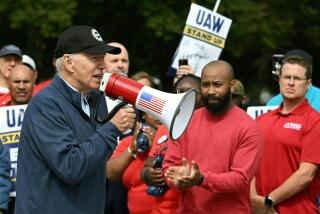Groups set out to protect U.S. jobs in stimulus bill
Anti-illegal-immigration groups launched a campaign late last year to ensure that any jobs created by the economic stimulus package go to Americans and not to illegal immigrants.
So when the House bill passed this week with a provision designed to do just that, they declared victory.
âWhat sense does it make to spend hundreds of billions of dollars in borrowed money to create jobs if those jobs arenât going toward American workers?â said Ira Mehlman, spokesman for the Federation for American Immigration Reform.
An amendment to the House bill, sponsored by Rep. Jack Kingston (R-Ga.), would require contractors that receive federal funds through the bill to verify the immigration status of their employees using a controversial program called E-Verify.
At least two senators have indicated they will push for a similar measure in the Senate version of the stimulus bill.
Immigrant rights groups have countered with their own mobilization, urging legislators to keep worker verification requirements out of the stimulus package. Requiring businesses to enroll in E-Verify could only slow the influx of money and jobs into the economy, said Tyler Moran of the National Immigration Law Center.
âIt is going to delay the stimulus,â she said. âIt doesnât belong here.â
E-Verify is a free Web-based program that checks the legal status of employees by matching identification information -- such as name and Social Security number -- with federal databases. As of Jan. 8, 100,000 employers had signed up for the voluntary program, according to U.S. Citizenship and Immigration Services.
Registering would be burdensome and costly for small businesses, said Angelo Amador, director of immigration policy for the Chamber of Commerce. He also said legislators should save the immigration discussion for another time.
âImmigration is a heated debate that I donât think we should be having on this bill,â he said.
Worker verification is one of several moves the federal government has taken in recent years to remove illegal immigrants from the workplace. The U.S. has put more resources into investigating businesses that may be hiring illegal workers, and imposing fines and filing criminal charges on those that are.
Since E-Verify was created in 1996, employers have verified the eligibility of more than 18 million workers, according to U.S. Citizenship and Immigration Services. More than 96% of qualified employees are cleared automatically by E-Verify, according to the agency.
An executive order that would require all federal contractors to use E-Verify was scheduled to go into effect next month, but the Obama administration pushed the date to May to allow more time to review the rule.
NumbersUSA head Roy Beck said E-Verify made it easier for good businesses to follow the rules and made it harder for unscrupulous ones to game the system. âIt doesnât keep every single illegal worker out, but itâs a step in the right direction,â he said.
But critics said the program relied on inaccurate databases and led to discrimination against foreign-born workers.
Sonia Ramirez, legislative representative for the AFL-CIO, said the program misclassified many U.S. citizens and legal workers. The program, which is used on a limited basis, is not âready for prime time,â Ramirez said.
âThe high error rates would come into play,â she said.
--
More to Read
Sign up for Essential California
The most important California stories and recommendations in your inbox every morning.
You may occasionally receive promotional content from the Los Angeles Times.










